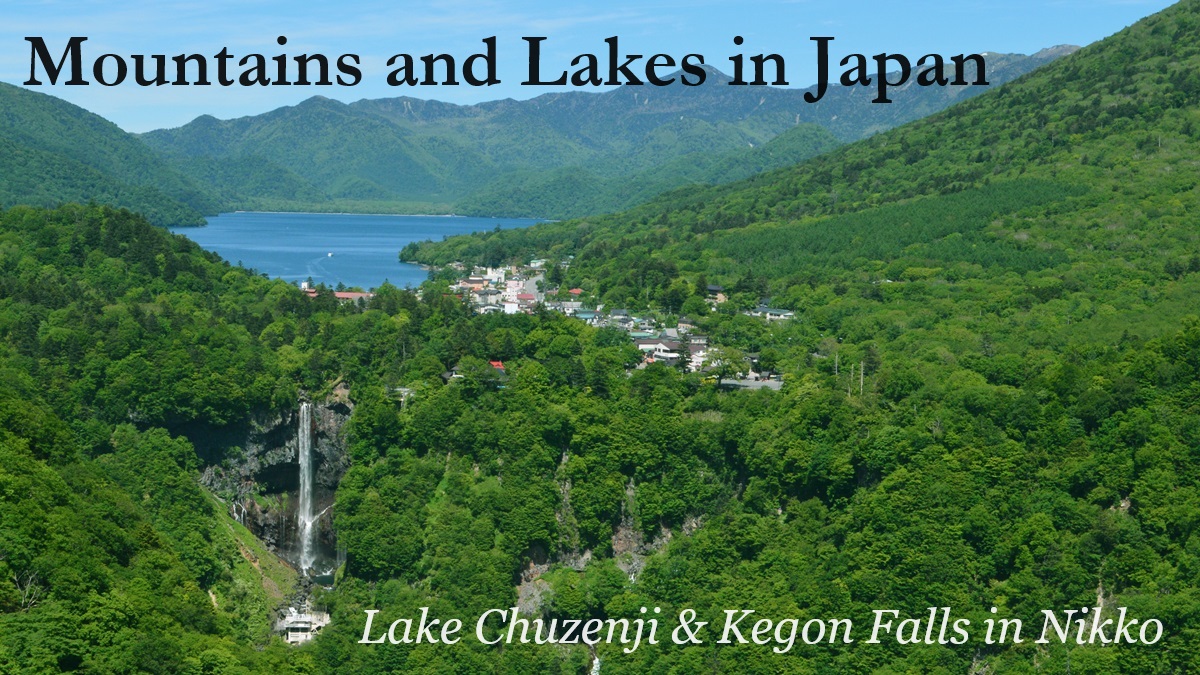Mountains and Lakes in Japan
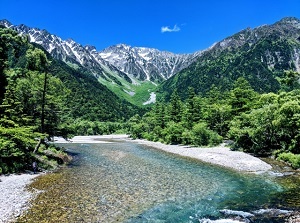
Northern Alps from Kamikochi
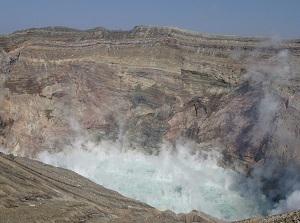
Crater of Mt.Aso volcano
Japan is a mountainous country.
In addition, there are many volcanoes because Japanese Islands is a part of the belt of volcanoes in the Pacific Ocean called "Ring of Fire".
Most lakes are dotted in the mountain and they are not so large.
Many of them were formed by volcanic activity and they are almost "caldera lake" that water has collected around the volcano.
There are many scenic mountains throughout Japan.
Some mountains have been worshiped as god since ancient times, so there are sacred Shinto shrines and Buddhist temples.
And, some mountains have onsen resorts.
In addition, popular ski resorts are around some mountains.
Mountains and lakes are also good sightseeing spots.
Mount Fuji
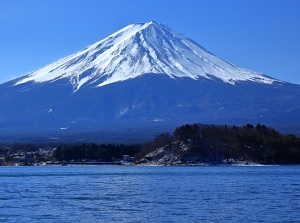
Mt.Fuji from Lake Kawaguchi
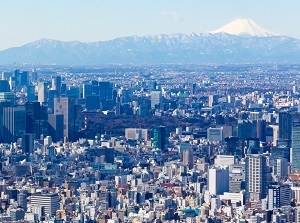
Mt.Fuji from Tokyo
Mount Fuji is the most famous mountain in Japan and is called "Fujisan" (富士山) in Japanese.
Mount Fuji is the highest mountain in Japan.
Its altitude is 3,776 meters and is located about 100 km west of Tokyo.
It is a volcano but the last eruption was over 300 years ago.
The beautiful and majestic figure has been a subject of faith since ancient times, and it is a spiritual home of Japanese people.
The northern foot of Mt.Fuji is a resort area with five lakes and we can see the excellent scenery closely.
The roads for bus and car lead to the fifth station.
The tourist can go there.
Only in July and August, climbing to the top is allowed.
The climber need to a good equipment.
It takes over 8 hours to climb to and from the top.
Foreign tourists are increasing recently.
But careless, reckless and mannerless climber appears sometimes.
If you want to climb, you should prepare the suitable equipment and schedule.
In addition, take your garbage with you and don't pollute the natural environment.
Main mountains and lakes in each region
Hokkaido Tohoku Kanto Koshin-etsu Hokuriku Tokai Kansai Chugoku Shikoku Kyushu
Mountains and lakes in Hokkaido Region
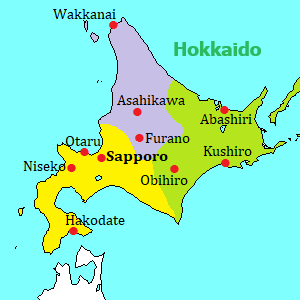
Southern part of Hokkaido Region
Niseko (ニセコ) is a popular ski resort around Mount Niseko-An'nupuri (1,308 m) and some peaks.
Australian skiers made Niseko more popular from around 2000, so it is just like a foreign resort town now.
From Niseko, we can see beautiful Mount Yotei (羊蹄山, 1,898 m) like Mt.Fuji.
Lake Shikotsu (支笏湖) is a caldera lake by eruption of volcano.
It is not so far from Sapporo city, but it is surrounded by nature.
Lake Toya (洞爺湖) is a scenic caldera lake by eruption of volcano.
There are an active volcano Mount Usu (有珠山, 737 m) and a new volcano Showa-shinzan (昭和新山, 398 m) which appeared suddenly from 1943 to 1945.
There is the onsen town on the lakeside.
Onuma (大沼) is a quasi-national park of Japan near Hakodate city at the southern end of Hokkaido.
There is Komagatake volcano (1,131 m) in the center of the area and Lake Onuma and a few small lakes are around the volcano.
Northern and eastern parts of Hokkaido Region
Daisetsuzan (Taisetsuzan) (大雪山) is a group of some volcanoes in the center of Hokkaido and the highest peak is 2,291 meters high.
A steep gorge Sounkyo is on the north side and there is onsen town.
Lake Akan (阿寒湖) is a caldera lake.
It is famous for "Marimo" which is a spherical moss.
There are the onsen town and the village of Ainu people.
Lake Mashu (摩周湖) is a caldera lake and the clarity of the water is the best in Japan.
So the water color is beautiful and mysterious blue.
Lake Kussharo (屈斜路湖) is also a caldera lake near Lake Mashu.
There is a hot spring spot on the lakeshore.
Lake Saroma (サロマ湖) is the largest lake in Hokkaido and faces Okhotsk Sea.
The long and narrow sand bank separates the lake from the sea.
The scenery is boundless.
Lake Shikaribetsu (然別湖) is a lake in the mountain to the west of Obihiro city.
There is no private home is around the lake and it is surrounded by nature.
The lake freezes in winter and the event by houses made of ice blocks on the lake is held.
Mountains and lakes in Tohoku Region
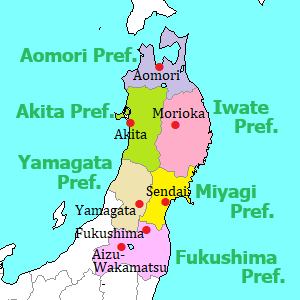
Hakkoda (八甲田, Aomori Pref.) is a group of volcanoes, and the highest peak is 1,584 m high.
The highland around the mountain is not so steep.
Much snow falls in winter, and we can see rime ice.
Lake Towada (十和田湖, Aomori Pref.) is a caldera lake, and it is located to the south of Hakkoda.
The lake is surrounded with forest, so the scenery is beautiful.
Oirase stream flows into the lake, and it is also a popular sightseeing spot.
Shirakami-Sanchi (白神山地, Aomori & Akita Prefs.) is a mountain area, and the primeval forests are 130,000 hectares in area.
Old beech forests extend on the mountains, and it is designated a World Heritage Site.
Hachimantai (八幡平, Iwate Pref.) is a group of volcanoes, and the highest peak is 1,613 m high.
Shapes of the mountains are gentle, so it is like a highland.
There are some small onsen village and ski resorts.
Ryusendo (龍泉洞, Iwate Pref.) is one of the most famous limestone caves, and it is in the mountains of Iwaizumi town.
The water of underground lakes has the world's top clarity.
The explored part of cave is over 2.5 km long.
Lake Tazawa (田沢湖, Akita Pref.) is a round lake about 6 km in diameter.
But it is the deepest lake in Japan (423m), so the deep blue color of the water is attractive.
Mount Zao (蔵王) is a group of many volcanoes between Yamagata and Miyagi Prefectures, and the highest peak is 1,841 m high.
The mountains have some scenic spots and hot springs.
Rime ice in winter is very famous, and the ski resort is also popular.
There is a popular crater lake Okama on the east side.
Three sacred mountains of Dewa (出羽三山) are dotted in the center of Yamagata Prefecture, and they are Mt.Haguro, Mt.Gassan and Mt.Yudono.
It is said that a prince performed the ascetic practices in the 6th century, so many mountain priests perform the ascetic and hard practices strolling in these mountains for over a week in early autumn.
Tourists can visit the Shinto shrines in each mountain.
Mount Bandai (磐梯山, 1,816 m) is a volcano located in the center of Fukushima Prefecture.
By the great eruption occured in 806, the volcano like Mt.Fuji became a mountain without the top.
Some lakes are dotted at the northern foot and the scenic area is called Ura-Bandai.
Lake Inawashiro (猪苗代湖) is located at the southern foot of Mt.Bandai and it is a scenic place to see Mt.Bandai.
The water of lake is acid under the influence of the volcanos and it is clear.
Mountains and laskes in Kanto Region
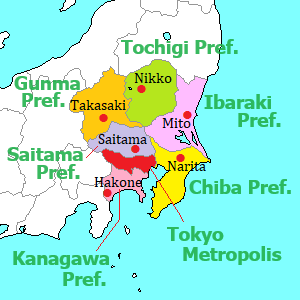
Mount Takao (高尾山, Tokyo Metropolis) is a mountain 599 meters high.
It is located in Tama area to the west of central Tokyo and it is a popular mountain to go hiking.
It takes only 1 hour by train from Shinjuku in Tokyo.
Hakone (箱根, Kanagawa Pref.) is the area in a whole caldera volcano.
It is a well-known onsen area close to Tokyo, and several onsen districts are dotted in the caldera.
And there is scenic Lake Ashi, so Hakone is a wide sightseeing spot.
Mount Tsukuba (筑波山, Ibaraki Pref.) is the only mountain in wide Kanto Plain, and the highest peak is 877 m high.
It has been the object of mountain worship since ancient times and there are a few shrines on the mountain.
Mount Takao Hakone Mount Tsukuba
Lake Chuzenji (中禅寺湖, Nikko city, Tochigi Pref.) is a dammed lake by the eruption of Mt.Nantai and it is located to the west of sacred city Nikko.
There is famous Kegon Falls at the place that a river flows out from the lake.
Mount Tanigawa (谷川岳, Gunma Pref.) is a mountain on the dividing ridge of Honshu island, and the highest peak is 1,977 m high.
It is one of the popular mountains for alpinist, and there are the spots for general tourist.
Mount Asama (浅間山, Gunma & Nagano Prefs.) is an active complex volcano, and the volcanic activity is still continuing.
There is Onioshidashi to the north, and we can see the real lava field erupted in 1783.
Lake Chuzenji Kegon Falls Mount Tanigawa Mount Asama
Mountains and lakes in Koshin-etsu Region
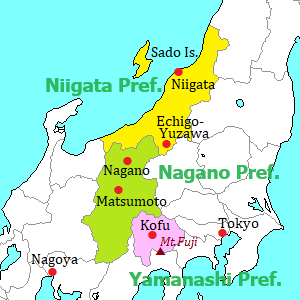
Yatsugatake (八ヶ岳, Yamanashi & Nagano Prefs.) is a group of volcanoes, and the highest peak is 2,899 m high.
There are some popular resort areas such as Kiyosato and Tateshina around the foot of the mountains.
Echigo-Yuzawa (越後湯沢, Niigata Pref.) is a mountain area on the western side of Mount Tanigawa.
It is in a heavy snowfall area in winter, so some popular ski resorts are dotted.
Mount Myoko (妙高山, Niigata Pref.) is an active volcano, and it is 2,454 m high.
There are some onsen resorts and ski resorts on the eastern slope.
Mount Togakushi (戸隠山, 1,904 m, Nagano Pref.) is a rocky mountain located about 20 km northwest of Nagano city.
Since ancient times, it was a place to perform the ascetic practices.
There are some shrines along the climbing road to the top.
Sado gold mine (佐渡金山, Niigata Pref.) is the ruin of gold mine in Sado Island, and it was designated as World Cultural Heritage Site in 2024.
It had been the largest gold and silver mine in Japan and had supported the finance of Edo government from the 17th to the 19th centuries.
Northern Alps is a mountain range along the northwest border of Nagano Prefecture and there are many peaks 2,000 to 3,000 meters high.
Yarigatake (槍ヶ岳, 3,180 m), Hotakadake (穂高岳, 3,190 m), Tsurugidake (剱岳, 2,999 m), Shiroumasake (白馬岳, 2,932 m), etc. are the main peaks.
They are popular with alpinists, and there are some resorts around them.
Kamikochi (上高地, Nagano Pref.) is a scenic valley around Hotakadake in Northern Alps.
It is an entrance place to Hotakadake, and general tourists can visit there.
Norikura Highland (乗鞍高原, Nagano Pref.) is the area on the east slope of Norikuradake (3,026 m) in the south part of Northern Alps.
There are some waterfalls and ponds, and Shirahone onsen resort is popular.
Hakuba village (白馬村, Nagano Pref.) is a village around the foot of Shiroumadake and Yarigatake in the north part of Northern Alps.
There are some popular ski resorts.
Ontakesan (御嶽山, Nagano & Gifu Prefs.) is an active volcano and the highest peak is 3,067 m high.
There are an onsen resort and some ski resort around the mountain.
It erupted in 2014, and 58 climbers around the top fell victim to the eruption.
Kiso-Komagatake (木曽駒ヶ岳, 2,956 m, Nagano Pref.) is a steep mountain and the cirque by glacial erosion is attractive.
A ropeway is operated to the bottom of the cirque.
Mountains and lakes in Hokuriku Region
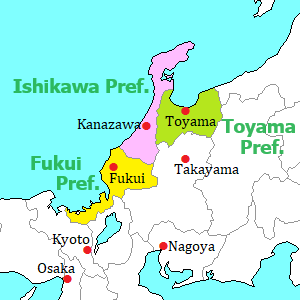
Tateyama Kurobe Alpine Route (Toyama Pref.) is a route crossing the Northern Alps from west to east.
The route passes beautiful Mount Tateyama (立山, 3,015 m) and huge Kurobe Dam.
There is no connecting road, so the tourists must use cable car, ropeway, special bus.
Kurobe Gorge (黒部峡谷, Toyama Pref.) is a steep gorge formed by Kurobe River flowing through the Northern Alps, and there is Kurobe Dam on the upper reaches of the river.
There is Unazuki Onsen at the entrance of the gorge and Kurobe Gorge Railway leads to the middle reach of the river.
Hakusan (白山, Ishikawa, Fukui & Gifu Prefs.) is a volcano and the highest peak is 2,702 m high.
Since ancient times, it has been a popular mountains to worship.
There is an old shrine, and waterfalls and hot spring are dotted around the mountain.
Mikata-goko (三方五湖, Fukui Pref.) is five small lakes near the sea.
All lakes are connected with a narrow channel or a canal.
The sightseeing ship is operated and the scenic highway is set up around the lakes.
Tateyama Kurobe Alpine Route Kurobe Gorge Hakusan Mikata-goko
Mountains and lakes in Tokai Region
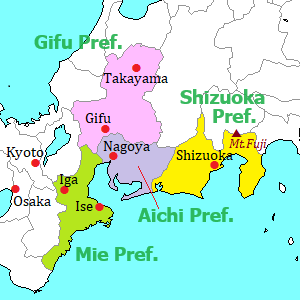
Mount Amagi (天城山, 1,406 m, Shizuoka Pref.) is a group of some volcanoes in Izu Peninsula and onsen villages are dotted.
Waterfalls are popular, and "wasabi" farms using the clear water are also seen.
Nihondaira hill (日本平, 307 m, Shizuoka Pref.) is a hill near Shizuoka city.
The top is a park with a few observatory, and the good view of Mt.Fuji is seen.
Lake Hamana (浜名湖) is near the Pacific Ocean and the southern end connects with the sea.
There are onsen resort and historic spot, and the farm raised eels around the lake are the speciality.
Oku-Hida Onsen village (奥飛騨温泉郷, Gifu Pref.) is the onsen villages on the western side of the mountains of Northern Alps.
There are five onsen villages in the steep valleys near the mountains.
There is the observatory to see beautiful Hotakadake and the ropeway is operated.
Mount Gozaisho (御在所岳, 1,212 m, Mie Pref.) is a rock mountain.
There is Yunoyama onsen town, and it is not so far from large city Nagoya.
Rime ice of this mountain in winter is rare in this region and there is even a small ski slope.
Mount Amagi Nihondaira Lake Hamana Oku-Hida Onsen village Mount Gozaisho
Mountains and lakes in Kansai Region
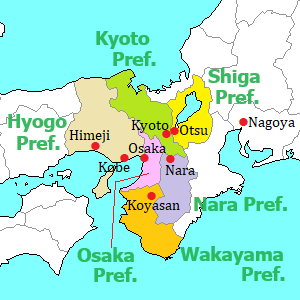
Lake Biwa (琵琶湖, Shiga Pref.) is the largest lake in Japan, and it occupies the wide area of Shiga Prefecture.
There is Otsu city at the southern end of the lake and Kyoto city is located just west of Otsu.
In the ancient time, Lake Biwa was a route of water transportation to Kyoto.
And the main roads from Edo (Tokyo) to Kyoto passed around the lake.
So, some old towns are dotted near Lake Biwa.
Mount Hiei (比叡山, 848 m, Shiga Pref.) is a mountain between Kyoto city and Otsu city facing Lake Biwa.
There is a large Buddhist temple Enryakuji near the peak.
Mount Rokko (六甲山, Kobe city, Hyogo Pref.) is a mountain range just north of city area in Kobe.
There are some observatories around the top, and it is said that Mt.Rokko is one of the major night views in Japan.
Wakakusayama (若草山, 342 m, Nara Pref.) is a low mountain on the east side of Nara city.
The top has a fine view of the ancient city and there are wild deer, the symbol of Nara.
Yoshinoyama (吉野山, Nara Pref.) is the mountains in the center of Nara Prefecture.
There are 30,000 cherry trees in the wide area of the mountains, so this is the Japan's largest place famous for its cherry blossoms.
Koyasan (高野山, Wakayama Pref.) is a sacred town of Buddhism in the deep mountain.
In the 9th century, Kuukai who was one of the greatest Buddhist priests in Japan constructed the town to practice Buddhistic austerities in the mountain.
There are many temples and many priests still practice asceticism.
Kumano Kodo (熊野古道, Wakayama Pref.) is the collective name of the ancient pilgrimage routes leading to Three Grand Shrines of Kumano (Wakayama Pref.)
The routes are from Yoshinoyama and Koyasan, etc. and pass through almost in deep mountains, and they were registered as UNESCO World Heritage.
Mountains and lakes in Chugoku Region
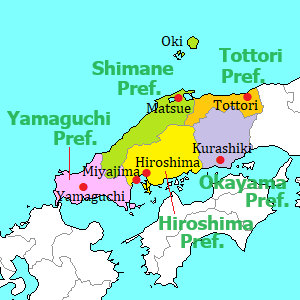
Mount Washu (鷲羽山, 133 m, Okayama Pref.) is a small mountain on a small peninsula.
From the observatory, visitors can the scenary of Seto Inland sea with many islands and the bridge connecting Shikoku Island.
Mount Daisen (大山, Tottori Pref.) is a large volcano and the highest peak is 1,729 m high.
The shape is similar to Mt.Fuji, so Daisen has been worshipped as a god since ancient times.
It is an attractive object in this area.
Lake Shinji (宍道湖, Shimane Pref.) is a brackish lake, and stretches to the west of central Matsue city.
Shijimi clam in Lake Shinji is well-known, and various fishes are produced.
The view of sunset is popular.
Iwami Ginzan Silver Mine (石見銀山, Shimane Pref.) is the former Japan's largest silver mine and it is designated as a World Heritage site.
It is in a valley in the mountainous area.
Akiyoshidai (秋吉台, Yamaguchi Pref.) is a karst tableland, and is located to the west-northwest of Yamaguchi city.
We can see the undulating karst landscape dimpled with many dolines and countless limestone pinnacles up to 2 meters in height.
There is Akiyoshido limestone cave under Akiyoshidai, and a course about 1 km long is opened to the public.
Mount Washu Mount Daisen Lake Shinji Iwami Ginzan Silver Mine Akiyoshidai
Mountains and lakes in Shikoku Region

Iya valley (祖谷渓, Tokushima Pref.) is a huge V-shaped valley in the deep mountains.
We can see the people's life in the small village on the steep area.
Mount Godai (五台山, 146 m, Kochi Pref.) is a small mountain by Kochi Port.
It is an observatory in Kochi city, and there is Chikurinji temple, the 31st temple of 88 temples of Shikoku Pilgrimage.
Ryugado (龍河洞, Kochi Pref.) is one of the most famous limestone caves, and it is in the mountains to the east of Kochi city.
A ruin of dwelling place in primitive age were discovered in the cave.
The explored part of cave is about 1 km long.
Iya Valley Mount Godai Ryugado
Mountains and lakes in Kyushu Region
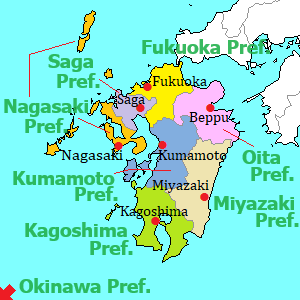
Unzen (雲仙, Nagasaki Pref.) is an active volcano and the highest peak is 1,483 m high.
It erupts sometimes, but it has been a tourist resort since ancient times.
There are onsen town and sightseeing spots around the mountain.
Mount Aso (阿蘇山, Kumamoto Pref.) is one of the world's largest caldera volcano.
There is a large central cone and the highest peak is 1,592 m high.
And the outer rim about 18 to 25 km across surrounds the caldera.
In the large crater, there are some sight seeing spots.
Sakurajima (桜島, 1,117 m, Kagoshima Pref.) is an active volcano, and it stands just in front of central Kagoshima city.
It often erupts and volcanic ash falls on the city sometimes.
It is said that the scenery of the volcano and the city is similar to Naples in Italy.
Yakushima (屋久島, Kagoshima Pref.) is an island to the south of Kagoshima, and the shape is round about 24 to 28 km across.
The whole area is mountainous and there is the mountain 1,936 meters high.
The forest covered all over the mountains is the natural treasury.

